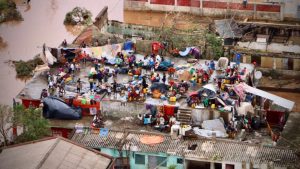SOURCE: AL JAZEERA AND NEWS AGENCIES
‘Women, babies trapped in trees’ after deadly Mozambique storm Six days after Cyclone Idai, rescuers scramble to save hundreds stranded by floodwaters amid fears death toll will rise.
Rescue workers in Mozambique are racing against time to save hundreds of people clinging onto roofs and trees around the devastated city of Beira, days after a powerful cyclone triggered flash floods, submerging entire villages and wiping out communities across southeastern Africa.
Aid workers on Wednesday spoke of women trapped in trees “throwing their babies” onto rescue boats and plucking people from head-deep water, only to strand them in patches of land where the water reached their ankles.
Cyclone Idai hit Beira with winds of up to 170 kilometres per hour last Thursday, then moved inland to Zimbabwe and Malawi, killing hundreds and putting the lives of millions at risk.
United Nations officials say this could be the worst ever weather-related disaster to have struck the southern hemisphere.
Authorities say at least 200 people have died in Mozambique and 98 in Zimbabwe, but the death toll is likely to rise as rescuers are still finding bodies.
Mozambican President Filipe Nyusi, who has declared a national emergency and three days of mourning starting on Wednesday, has warned that the eventual number of those killed in the cyclone and flooding could rise to more than 1,000.
‘It’s just water, you can’t see any land’
According to earlier estimates by the International Federation of Red Cross and Red Crescent Societies, 90 percent of Beira and its surrounding areas appear to be “completely destroyed”.
Josias Elias, found clinging to a tree almost submerged in water, said his entire village near Beira was flooded.
“There’s no more reason to go back. All of our houses have been destroyed,” he told Al Jazeera.
On Tuesday, rescuers saved 167 people around Beira with the help of South African Air Force helicopters.
On Wednesday, roads in and around the city of some 500,000 people was continuing to fall, complicating rescue efforts and meaning that aid had to be flown in by helicopter or plane.
“The devastation is vast. As far as the eye can see, it’s just water, you can’t see any land,” Travis Trower, of the Rescue South Africa group, told Al Jazeera in Beira. “Paddling through water, and seeing [survivors] in the trees was absolutely devastating.”
Recounting one rescue operation in the area on Friday, he said: “The women were throwing their babies from the trees into our paddle boats. We only managed to get only 20 children before we had to call off the operation.
“Unfortunately, when we went back to that place in the morning, those people were no longer there.”
|
|
‘Major humanitarian emergency’
Six days after the cyclone made landfall, rescuers are still in the “life-saving phase”, said Pedro Matos, emergency coordinator for the UN’s World Food Programme.
“We are now at the point on taking people who have water up to their heads and taking them by helicopter or boat to places where they are stranded up to their ankle,” he told Al Jazeera in Beira.
“We are not even at a phase where we can do medical assessments because they have been out there for many days drinking stale water with bodies and animals.”
The full extent of the devastation will only be known once floodwaters from torrential rains recede. It will be days before Mozambique’s inundated plains drain towards the Indian Ocean, and aid groups have warned the waters are still rising.
Al Jazeera’s Fahmida Miller, reporting from Beira, said the city’s residents were scrambling for food, fuel and medicine.
Speaking from a school where hundreds had taken shelter, Miller said: “There are several families crammed into one classroom. They may have found shelter, and some water has been delivered, but there is little in the way of food.”
 |
| People gather on the roof of a house submerged by floods in Buzi on Wednesday [Adrien Barbier/ AFP] |
